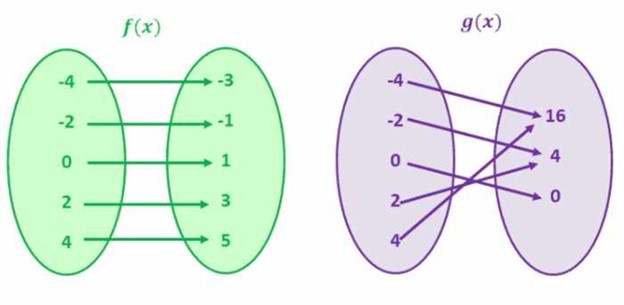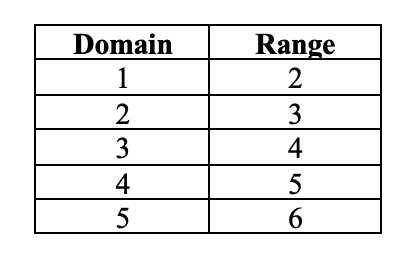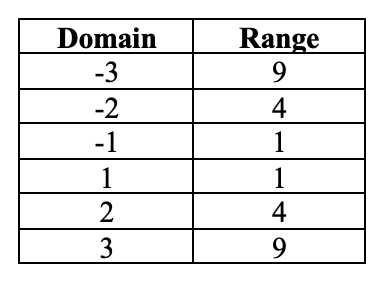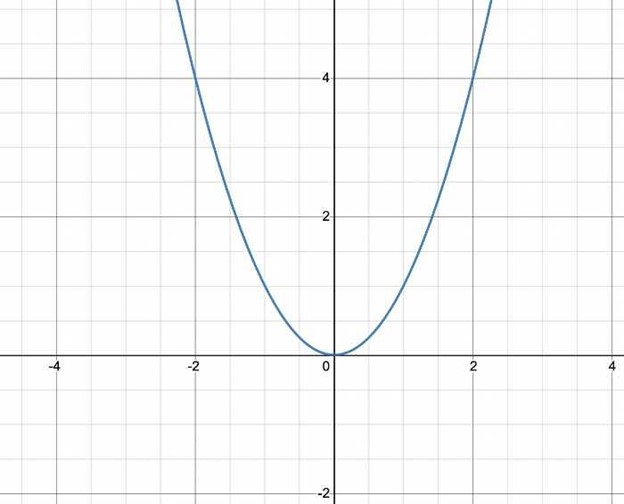One to One Functions - Graph, Examples | Horizontal Line Test
What is a One to One Function?
A one-to-one function is a mathematical function where each input corresponds to just one output. So, for each x, there is just one y and vice versa. This implies that the graph of a one-to-one function will never intersect.
The input value in a one-to-one function is known as the domain of the function, and the output value is the range of the function.
Let's examine the pictures below:

For f(x), every value in the left circle corresponds to a unique value in the right circle. Similarly, every value in the right circle correlates to a unique value in the left circle. In mathematical terms, this means that every domain has a unique range, and every range owns a unique domain. Thus, this is an example of a one-to-one function.
Here are some additional representations of one-to-one functions:
-
f(x) = x + 1
-
f(x) = 2x
Now let's look at the second image, which shows the values for g(x).
Pay attention to the fact that the inputs in the left circle (domain) do not hold unique outputs in the right circle (range). For instance, the inputs -2 and 2 have identical output, that is, 4. In conjunction, the inputs -4 and 4 have equal output, i.e., 16. We can discern that there are matching Y values for numerous X values. Hence, this is not a one-to-one function.
Here are different representations of non one-to-one functions:
-
f(x) = x^2
-
f(x)=(x+2)^2
What are the properties of One to One Functions?
One-to-one functions have these characteristics:
-
The function has an inverse.
-
The graph of the function is a line that does not intersect itself.
-
They pass the horizontal line test.
-
The graph of a function and its inverse are identical concerning the line y = x.
How to Graph a One to One Function
When trying to graph a one-to-one function, you will have to determine the domain and range for the function. Let's study an easy example of a function f(x) = x + 1.

As soon as you have the domain and the range for the function, you ought to chart the domain values on the X-axis and range values on the Y-axis.
How can you tell whether or not a Function is One to One?
To test if a function is one-to-one, we can use the horizontal line test. Once you chart the graph of a function, trace horizontal lines over the graph. In the event that a horizontal line passes through the graph of the function at more than one point, then the function is not one-to-one.
Since the graph of every linear function is a straight line, and a horizontal line doesn’t intersect the graph at more than one point, we can also reason that all linear functions are one-to-one functions. Remember that we do not leverage the vertical line test for one-to-one functions.
Let's study the graph for f(x) = x + 1. Immediately after you graph the values for the x-coordinates and y-coordinates, you ought to examine if a horizontal line intersects the graph at more than one place. In this example, the graph does not intersect any horizontal line more than once. This signifies that the function is a one-to-one function.

On the other hand, if the function is not a one-to-one function, it will intersect the same horizontal line more than once. Let's study the diagram for the f(y) = y^2. Here are the domain and the range values for the function:

Here is the graph for the function:

In this instance, the graph meets multiple horizontal lines. Case in point, for both domains -1 and 1, the range is 1. In the same manner, for both -2 and 2, the range is 4. This means that f(x) = x^2 is not a one-to-one function.
What is the inverse of a One-to-One Function?
As a one-to-one function has just one input value for each output value, the inverse of a one-to-one function also happens to be a one-to-one function. The opposite of the function basically reverses the function.
For Instance, in the event of f(x) = x + 1, we add 1 to each value of x for the purpose of getting the output, or y. The opposite of this function will subtract 1 from each value of y.
The inverse of the function is known as f−1.
What are the qualities of the inverse of a One to One Function?
The qualities of an inverse one-to-one function are identical to any other one-to-one functions. This means that the reverse of a one-to-one function will have one domain for every range and pass the horizontal line test.
How do you find the inverse of a One-to-One Function?
Determining the inverse of a function is simple. You simply need to swap the x and y values. For example, the inverse of the function f(x) = x + 5 is f-1(x) = x - 5.

As we discussed earlier, the inverse of a one-to-one function reverses the function. Because the original output value required us to add 5 to each input value, the new output value will require us to deduct 5 from each input value.
One to One Function Practice Examples
Consider these functions:
-
f(x) = x + 1
-
f(x) = 2x
-
f(x) = x2
-
f(x) = 3x - 2
-
f(x) = |x|
-
g(x) = 2x + 1
-
h(x) = x/2 - 1
-
j(x) = √x
-
k(x) = (x + 2)/(x - 2)
-
l(x) = 3√x
-
m(x) = 5 - x
For any of these functions:
1. Identify whether the function is one-to-one.
2. Plot the function and its inverse.
3. Determine the inverse of the function numerically.
4. Specify the domain and range of both the function and its inverse.
5. Employ the inverse to find the solution for x in each equation.
Grade Potential Can Help You Master You Functions
If you happen to be having problems trying to understand one-to-one functions or similar functions, Grade Potential can set you up with a one on one instructor who can support you. Our Stanford math tutors are experienced educators who support students just like you improve their skills of these types of functions.
With Grade Potential, you can learn at your own pace from the comfort of your own home. Schedule a call with Grade Potential today by calling (650) 590-5396 to learn more about our tutoring services. One of our team members will contact you to better ask about your requirements to set you up with the best teacher for you!




